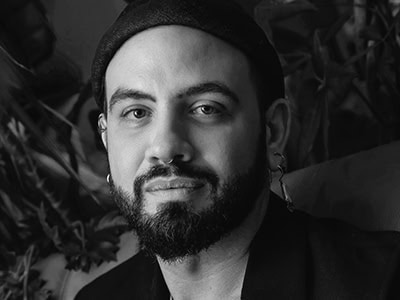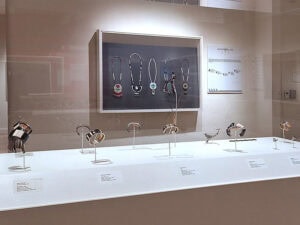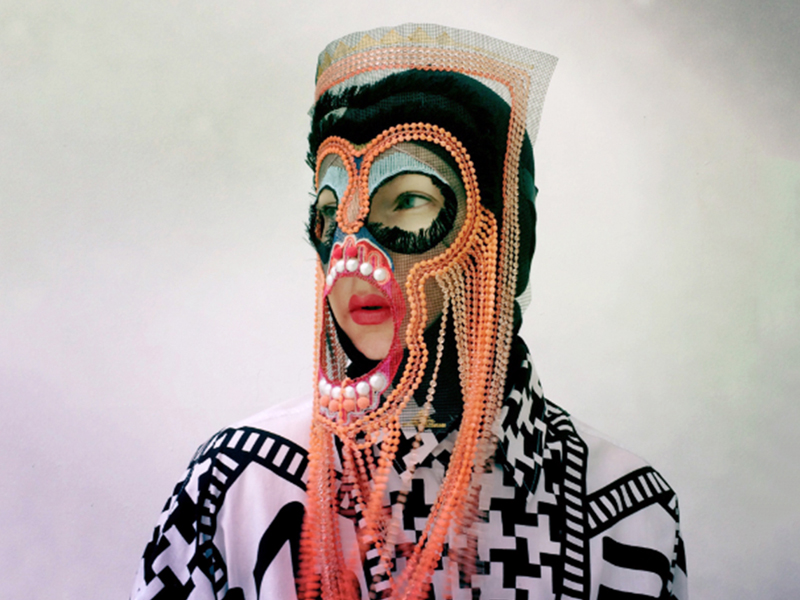
Magnhild Kennedy, a.k.a. Damselfrau, is a Norwegian artist living in London. A self-taught maker of masks, Kennedy dances on the blurry lines of fashion, design, and craft, a space she isn’t wanting to define. Although she doesn’t consider herself a jeweler, her work has a strong dialogue with the field.
I am extremely interested in the “outsider jeweler” quality of objects that speak to jewelry and adornment but were not necessarily originally intended to participate in this dialogue. I find especially interesting Kennedy’s opportunistic disregard for boundaries: She is happy to do “proper” exhibitions, to be featured in music videos, but also to disseminate her work, pretty much without definitional markers, online. Also remarkable is a propensity to stage herself at the center of reenactment or role-playing mise-en-scène: This strategy—where makers become their own fabricated persona—is not unlike Leslie Boyd’s, Jêrome Dauphin’s, or Brittany Britton’s, and is somewhat of a emergent trend in the field of contemporary jewelry.
Matt Lambert: Could you give me a little background on yourself? Your work can be found in quite a few places online, but I have yet to find a lot of information on you. Where are you from? Where do you reside now? Where did you study?
Magnhild Kennedy: I’m from Trondheim, Norway. I moved to London in 2007, and have lived there since. I never studied anything relevant to the work I do now, except for a very sanguine, unfinished year of arts in college. I grew up in a home where both parents were artists, so I’d say that was my schooling. I never learned crafts or textile work, though; those skills I developed on my own slowly through the years, learning through looking at clothes and crafts, trial and error, and watching YouTube tutorials.
You go by two different names posted online: Magnhild Kennedy and Damselfrau. Are these names interchangeable, or do you use them at different times for specific reasons?
Magnhild Kennedy: I use Damselfrau for the mask project as it seemed like a good name for it, a word that masks itself. It says unmarried and married woman in the same word; it’s a name I initially used as my Skype name way before the masks emerged. To me it has come to mean something like “married to oneself.” My real name has just naturally begun popping up beside the Damselfrau name in online searches; either name can be used.
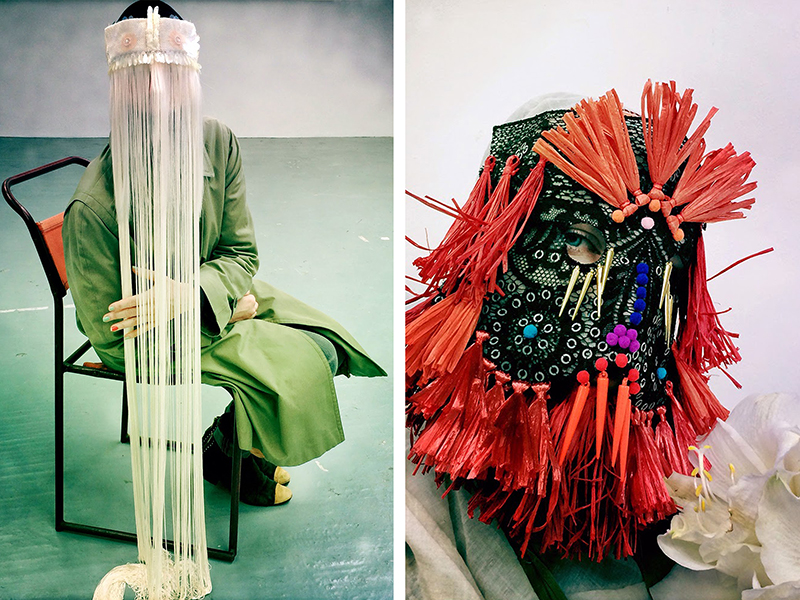
How did you get involved with mask making? Where did you develop the skills for it?
Magnhild Kennedy: When I first moved to London, me and my man, Robert, would go out to nightclubs a lot. Boom Box and Last Tuesday Society. Full-on dress up. At some point I made us some masks and it stuck. I just kept on making them. At the time, I was working in this little vintage designer shop in Islington, and my boss would let me sit and sew my own stuff behind the counter. I learned a lot looking at the fancy old clothes in the shop. I’d turn them inside out and some were disintegrating and I could get a proper look at the work and the craftsmanship.
Where do you find your inspiration when creating?
Magnhild Kennedy: Materials mostly. I take apart old stuff, skip dive, go to markets, eBay. Every morning I scan Tumblr. Architecture, animal vids, fashion, plants, art, whatever. I’m a big sci-fi and fantasy fan. My all-time faves are comics by Jean Giraud and Enki Bilal. Whilst I work, I watch a lot of film and TV series. If I like something a lot, I’ll watch it back to back, several times. It will get the juice flowing, proper. But the material drives the whole thing.
A summary on Juxtapoz mentions that you favor using found or second-hand materials. What motivates you to seek out these materials?
Magnhild Kennedy: Initially I only used old stuff as it already came with information, it always helped the process and it felt more like my work was a part of something that was already there. It gave it some weight. One of my reasons for moving to London was the wide range of old objects that could be found here, and the museums. Stuff, really. The stuff you could get here in a car boot sale from someone’s attic for close to nothing was mind blowing. Old lace and beads and antique pieces of clothing I could rip into.
In Norway these things are not easy to get your hands on, and if you do, they’re not cheap. Now I’m less dependent on using old materials, it has become easier for me to get stuff going. Now I’ll use anything.

In your process do you start with these found materials and build forms from them, or do you already have a concept and search for materials that fit your ideas?
Magnhild Kennedy: I never draw or design anything, it will start with a piece of “stuff,” material, something. A whole group of masks can come out of a pompom. I just sculpt as I go along. Easy. No overthinking. I have a manic side to me and it comes in handy when I have to focus for a long time on detailed work.
What characteristics define a mask for you, as opposed to a hood or a veil? Do you find the distinction between the two words important within your work?
Magnhild Kennedy: No. Mix this stuff up. It’ll take it somewhere new. A lot of my work meets somewhere in the middle. It’s funny, I’m not especially interested in mask as category.
One singular aspect of your masks is that they hide (the face) while drawing attention to themselves, like an elaborate trap for the eyes. Isn’t there a bit of tension between concealing and baiting?
Magnhild Kennedy: Absolutely, it’s open for different interpretation from the wearer and the beholder. It’s a place of freedom from yourself and/or others. A place of privacy and intimacy.
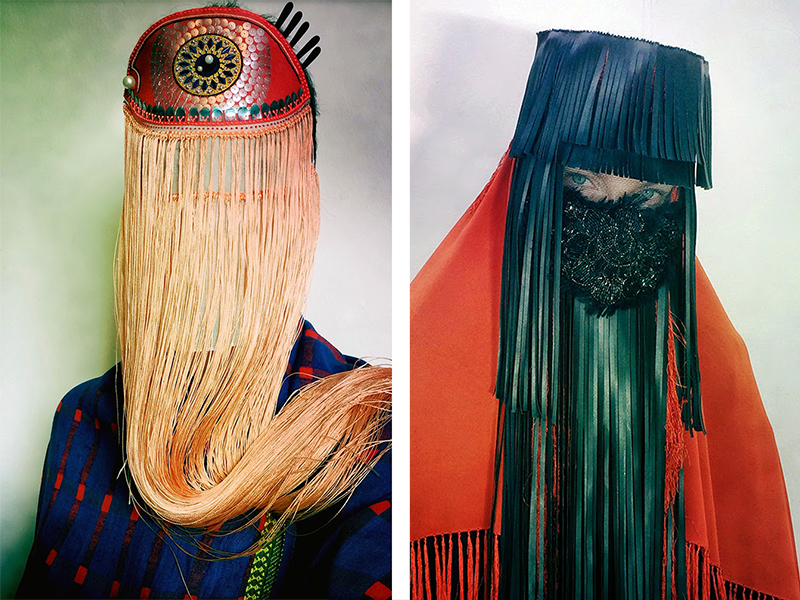
Our European and Middle-Eastern readership will probably want to see a connection (or play) between your masks and the policies that have been put in place in the last few years to restrict or protect Muslim women’s right to wear a veil in the public space. Some describe face-covering veils (hijab, chador, or burka) as a challenge to women’s sovereignty over their own bodies. Is this a conversation you feel part of?
Magnhild Kennedy: No. If the work does that, it does it of its own accord, and I don’t mind. I get this question occasionally; I don’t have a good answer. Everyone should be able to wear whatever they want.
As a maker of masks, where do you see your work fitting in the world of the gallery, the runway, the editorial image, and the performing body?
Magnhild Kennedy: Anywhere it wants to go. In 2011, a gallerist saw my pieces in a shop window and offered me a gallery show, and it felt natural and good to remove the masks from the body and discover they work well on their own as objects. These last few years I have done more pieces for theater and stage and have had to attack the projects from different angles and think function and impact from afar. It has changed the work in general. I used to be very fixated on detail. I am better at working with bigger strokes now.

We are witnessing what looks like a surge in mask- and costume-making across disciplines: I am thinking for example of Nick Cave’s costumes, Brian Jungen’s masks, and numerous examples from fashion photography. What are some of your thoughts on this?
Magnhild Kennedy: Hard to say. I haven’t really given this much thought, so I’ll let myself ramble a bit here. First, it seems like lines around people’s work are getting more and more blurred. We need more elements to make a full picture and a full experience. Everything is possible. The Internet has opened a space for more collaboration and we learn more from each other. I guess masks, in particular, are powerful as they have no gender in principle and offer privacy in a world where we are so over-engineered in our everyday lives and presentation, and branding is everything. I think we are in great need of excitement. We are served huge amounts of tragedy every day. We are so over-informed and full. There is a general need for fantastical creations, films, games, and music to take us somewhere else. So much exciting stuff is happening at the moment in every line of creative work. There is a wonderful reaction going on all over the place, to the supposed “perfection” of people’s lives.
Because we’re doing this interview for Art Jewelry Forum, a platform dedicated to the study of contemporary jewelry practices, I must ask: What relationship does your work have to jewelry?
Magnhild Kennedy: The masks are wearable adornment, so I guess they can be jewelry, too?

What is a favorite or memorable project that you have worked on?
Magnhild Kennedy: Last year I was asked by the creative director of Another Man, Alister Mackie, if I wanted to do a piece with buttons for the magazine. Louis Vuitton supplied me with thousands of buttons, and the piece I made was shot as an autonomous object and I talked a bit about how it came about. Julia Hetta shot a whole series with other Damselfrau masks for the same magazine. It was a big deal for me. That was cool.
My photographer/filmmaker friend Fiona Garden brought me in to work with her and Daphne Guinness for Daphne’s video, “Marionettes,” from her album Optimist in Black. A very cool experience. Daphne is used to the best of couture and craftsmanship, so if she thought my work was good I gathered it had to be true. For a self-taught person, it meant everything. I kind of came of age in my work through that experience. It did wonders for my confidence in the work.
Norwegian playwright Lisa Lie has engaged me to do pieces for two of her plays. I’m a huge fan of hers and it has been such a privilege to work with her. Her plays are absurd and full of information, and to work with the stage has been a great learning curve.
All these people let me have freedom to do what I like, so the work feels really good and like it’s in the right place. I don’t promote the work, but I have an Instagram account, a blog, a Tumblr, and a FB page. If people find my work on their own, it will hit the right people, and the most important thing is that the masks represent themselves.
In November of last year, me and Robert produced my latest exhibition, Idios, at Dalston Pier in London ourselves. It was a fab experience, very good learning.
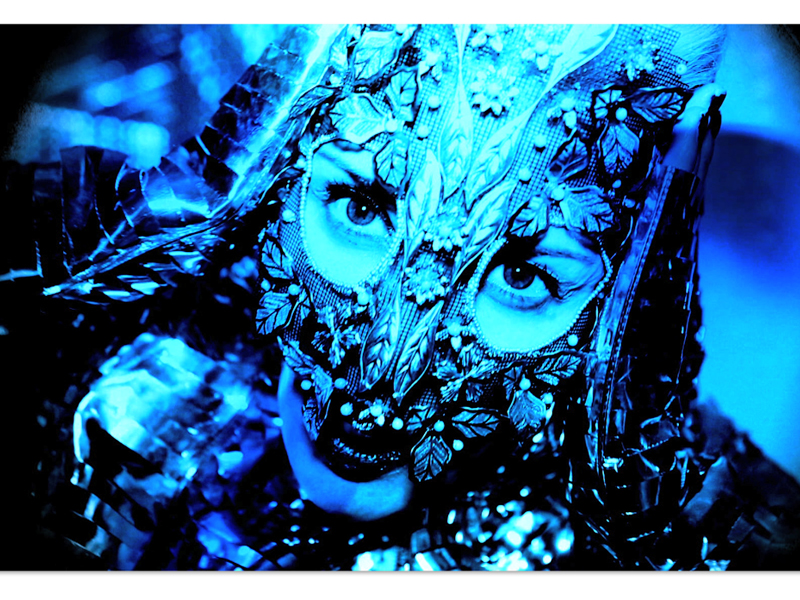
Are there any projects on the horizon we can be looking out for? Where can we see more of your work?
Magnhild Kennedy: My friend Ben Ashton is a photorealistic painter, his work is exquisite. He has photographed himself with my masks on, and he is doing a whole series of large paintings due to go on show this October at Cob Gallery in Camden, London. I have already seen the finished works, and from only being used to seeing the masks in the flesh or photographed, to see them painted, it’s a whole different animal.
Which films or books have made an impression on you recently?
Magnhild Kennedy: Mad Max was fab. I’ll watch anything post-apocalyptic. Matteo Garrone’s Tale of Tales from last year was fantastic. Before They Pass Away by Jimmy Nelson—so nice I cried when I first read it. Roger Ballen’s Outland. To Build a House You Start with the Roof, by Franz West. And the book Paul Klee: Hand Puppets, by Christine Hopfengart and Osamu Okuda: bewitching stuff.
INDEX IMAGE: Damselfrau, Daefni Hellore, 2015, mask, mixed media, selfie
